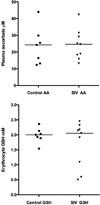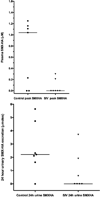Immunogenicity of trimethoprim/sulfamethoxazole in a macaque model of HIV infection
- PMID: 27565715
- PMCID: PMC5069186
- DOI: 10.1016/j.tox.2016.08.010
Immunogenicity of trimethoprim/sulfamethoxazole in a macaque model of HIV infection
Abstract
Background: Sulfonamide hypersensitivity has a high incidence in HIV infection and correlates with low CD4+ counts, but the mechanisms are not understood. The aims of this study were to determine whether trimethoprim/sulfamethoxazole (TMP/SMX) led to SMX adduct formation, immunogenicity, or signs of drug hypersensitivity in SIV-infected rhesus macaques, and whether differences in antioxidants, pro-inflammatory mediators, or SMX disposition were predictive of drug immunogenicity.
Methods: Nine macaques chronically infected with SIVmac239 and 7 non-infected controls were studied. Baseline blood ascorbate, glutathione, IFN-γ, LPS, sCD14, and cytochrome b5 reductase measurements were obtained, macaques were dosed with TMP/SMX (120mg/kg/day p.o. for 14days), and SMX metabolites, lymph node drug adducts, drug-responsive T cells, and anti-SMX antibodies were measured.
Results: Four of 9 of SIV-positive (44%), and 3 of 7 SIV negative (43%) macaques had drug-responsive T cells or antibodies to SMX. Two macaques developed facial or truncal rash; these animals had the highest levels of lymph node drug adducts. Antioxidants, pro-inflammatory mediators, and SMX metabolites were not predictive of drug immunogenicity; however, the Mamu DRB1*0401/0406/0411 genotype was significantly over-represented in immune responders.
Conclusions: Unlike other animal models, macaques develop an immune response, and possible rash, in response to therapeutic dosages of TMP/SMX. Studying more animals with CD4+ counts <200cells/μl, along with moderately restricted ascorbate intake to match deficiencies seen in humans, may better model the risk of SMX hypersensitivity in HIV-infection. In addition, the role of Mamu-DRB1 genotype in modeling drug hypersensitivity in retroviral infection deserves further study.
Keywords: Hypersensitivity; Idiosyncratic; SIV; Simian immunodeficiency virus; Sulfamethoxazole; Sulfonamide.
Copyright © 2016 Elsevier Ireland Ltd. All rights reserved.
Figures




Similar articles
-
Evaluation of sulfonamide detoxification pathways in haematologic malignancy patients prior to intermittent trimethoprim-sulfamethoxazole prophylaxis.Br J Clin Pharmacol. 2011 Apr;71(4):566-74. doi: 10.1111/j.1365-2125.2010.03889.x. Br J Clin Pharmacol. 2011. PMID: 21204907 Free PMC article.
-
A randomized trial of N-acetylcysteine for prevention of trimethoprim-sulfamethoxazole hypersensitivity reactions in Pneumocystis carinii pneumonia prophylaxis (CTN 057). Canadian HIV Trials Network 057 Study Group.J Acquir Immune Defic Syndr Hum Retrovirol. 1998 Dec 15;19(5):498-505. doi: 10.1097/00042560-199812150-00009. J Acquir Immune Defic Syndr Hum Retrovirol. 1998. PMID: 9859964 Clinical Trial.
-
Evaluation of the clinical, immunologic, and biochemical effects of nitroso sulfamethoxazole administration to dogs: a pilot study.Toxicology. 2005 Mar 1;208(1):63-72. doi: 10.1016/j.tox.2004.11.009. Toxicology. 2005. PMID: 15664433
-
The use of trimethoprim and sulfamethoxazole (TMP-SMX) in dermatology.Folia Med Cracov. 2015;55(1):35-41. Folia Med Cracov. 2015. PMID: 26774630 Review.
-
Atypical Severe Shock-like Reactions in Adolescents After Trimethoprim-Sulfamethoxazole Therapy.J Pediatric Infect Dis Soc. 2021 Apr 3;10(3):382-385. doi: 10.1093/jpids/piaa100. J Pediatric Infect Dis Soc. 2021. PMID: 32955095 Review.
Cited by
-
Antibiotic prophylaxis in immunosuppressed patients - Missed opportunities from trimethoprim-sulfamethoxazole allergy label.World Allergy Organ J. 2024 Jan 3;17(1):100856. doi: 10.1016/j.waojou.2023.100856. eCollection 2024 Jan. World Allergy Organ J. 2024. PMID: 38235260 Free PMC article. Review.
-
Drug hypersensitivity in HIV infection.Curr Opin Allergy Clin Immunol. 2019 Aug;19(4):272-282. doi: 10.1097/ACI.0000000000000545. Curr Opin Allergy Clin Immunol. 2019. PMID: 31145192 Free PMC article. Review.
-
Hepatic expression profiles in retroviral infection: relevance to drug hypersensitivity risk.Pharmacol Res Perspect. 2017 Apr 26;5(3):e00312. doi: 10.1002/prp2.312. eCollection 2017 Jun. Pharmacol Res Perspect. 2017. PMID: 28603631 Free PMC article.
References
-
- Ambrose Z, KewalRamani VN, Bieniasz PD, Hatziioannou T. HIV/AIDS: In search of an animal model. Trends Biotechnol. 2007;25:333–337. - PubMed
-
- Brenchley JM, Price DA, Schacker TW, Asher TE, Silvestri G, Rao S, Kazzaz Z, Bornstein E, Lambotte O, Altmann D, Blazar BR, Rodriguez B, Teixeira-Johnson L, Landay A, Martin JN, Hecht FM, Picker LJ, Lederman MM, Deeks SG, Douek DC. Microbial translocation is a cause of systemic immune activation in chronic HIV infection. Nat Med. 2006;12:1365–1371. - PubMed
MeSH terms
Substances
Grants and funding
LinkOut - more resources
Full Text Sources
Other Literature Sources
Medical
Research Materials

